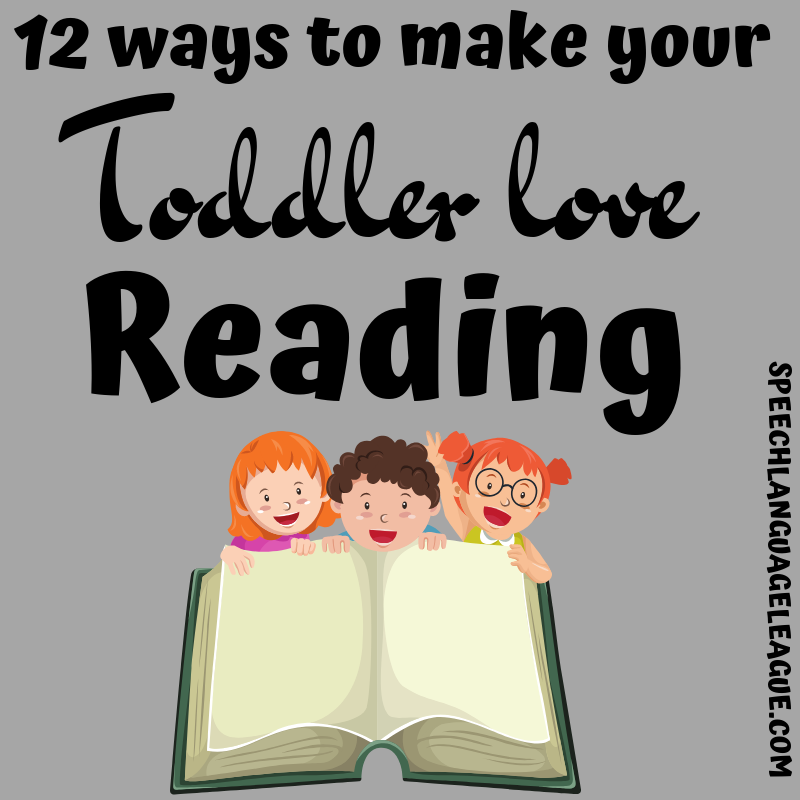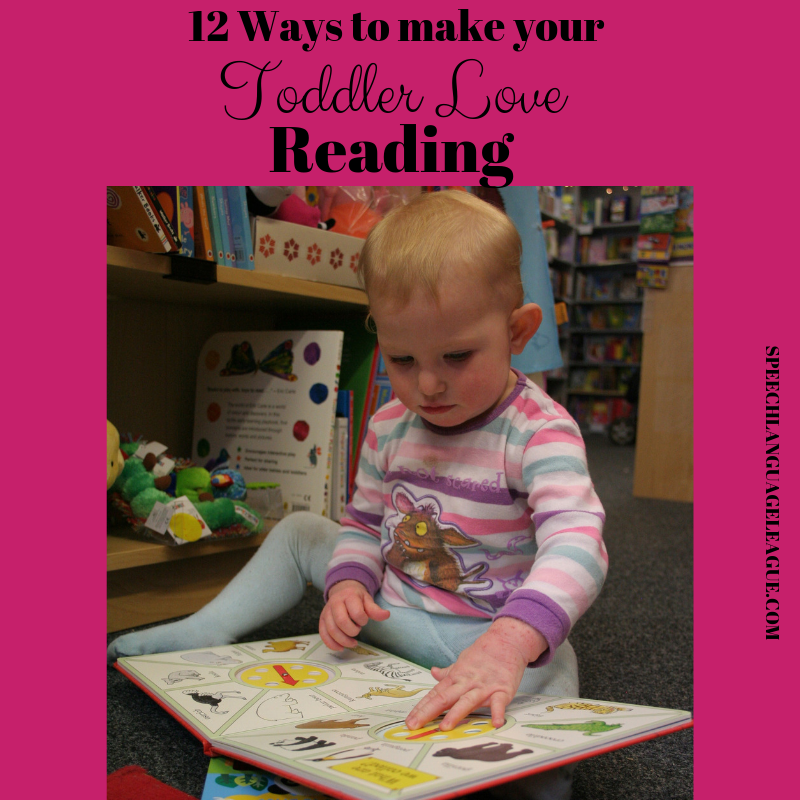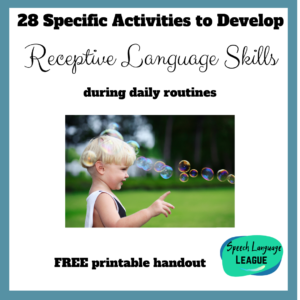SKILL: Listening to stories and interacting while reading

- Start early. Like at birth. If you are starting too late, no worries! The rest of this article will give lots of ideas to encourage your toddler to read…even if they aren’t so into it now! But if you have a less than 6-month old, start NOW! You will be glad you did!
- Don’t read the words. So many children’s picture books have lots of words. And if your child isn’t enjoying reading, it may be that she doesn’t have the attention span to listen to ALL THOSE WORDS. So just look at the pictures and talk about what you see. For example, if you are reading a book about a farm, you might point to a cow and say “Oooh, look, a cow. The cow says Moo. The cow is eating grass.”
- Read fast. Never force your child to sit and listen to a story when they are not interested. If you have their attention, and you know it may not last long…read fast! Just say a couple of words per page (like labeling one or two pictures per page) and turn the page! A lot of times, kids think this is funny. It also helps them to understand that there is an end to the book. It starts to build patience and attention span. Over time, as your toddler accepts this “fast reading”, you can gradually begin to spend more time reading each page.
- Be animated. For some, being animated may come naturally. For others, this may take some practice. I can assure you, that reading will be more engaging for your child if you are animated while you are doing it. Use lots of over-the-top intonation. Speak using exaggerated facial expressions. Use your hands, make gestures! Use different voices for different characters! All of these things just make reading more fun.
- Try singing. All toddlers love music! Try using familiar song choices in book form. There are plenty of books out there for classic songs, such Wheels on the Bus, Twinkle Twinkle Little Star, Itsy Bitsy Spider, Mary had a Little Lamb, etc. Instead of reading the words, just sing the song while you look at the pictures!
- Involve your child. Reading should be an interactive, shared experience. Have your child turn the pages, or turn the pages together. Ask your child to point to pictures or find items on the pages. Ask your child questions. If, at any point, your child does not answer a question or does not point to a picture…don’t require them to do so. Just do it yourself; this is called modeling or showing your child what you want them to do.
- Try repetitive books. Similar to singing, children love to hear the same things over and over again. It helps them to understand and anticipate what comes next. Some examples of repetitive books are Brown Bear, Brown Bear, What do you see?, I Went Walking, and That’s Not My Owl (and the whole That’s Not My …) series. When my son was about a year old, I could recite Brown Bear, Brown Bear to him without the book. To him, it was so familiar, it was like a song.
- Relate the book to personal experiences. Choose books that have subject matter that your child has had experience with. If you recently went to the zoo, you might read Put Me in the Zoo or Dear Zoo. If you encountered a caterpillar in your front yard, you might read The Very Hungry Caterpillar. If your child has been fascinated by the moon, try Goodnight Moon. You can also read about daily routines, that all children experience, such as The Going to Bed Book, Bath Time!, or Eating the Alphabet. Another great way to connect reading to personal experiences is to read about seasons and holidays. For Valentine’s Day, you can read Llama, Llama I love you; for Halloween, you can read Little Blue Truck’s Halloween; in the winter, read Snowmen at Night; in the summer, try Biscuit’s First Beach Day.
- Read everyday. Make reading a part of your daily routine. An easy time to do this is at bedtime. When I was home with my son on maternity leave, we always read a few books after breakfast.
- Let go of the idea that your child has to be sitting while you read. Especially when introducing reading as part of your routine, allow your child to play, walk around, jump up and down…whatever! You are modeling reading. Your child is listening to you. Your child is watching you. Your child is learning that books have a beginning, middle, and end. These are all good things and are steps in the right direction!
- Ask questions without expectation. Reading should not be a stressful experience for your child. This is not an opportunity to put them on the spot or quiz them. Ask questions. If they answer correctly, great! If they answer incorrectly or do not answer at all, just answer for them! It shows your child what you want them to do, while at the same time teaching vocabulary and language!
- Try interactive books. All children love interactive books. For those children who are not showing an interest in reading classic stories, interactive books may just get them to really show an interest in reading! Here are some examples of interactive books:
- Lift the flap books, such as Where’s Spot? or Where Baby’s Belly Button?
- Press-the-button books, such as Busy Noisy Farm or Around the Farm.
- Musical Books, such as VTech Musical Rhymes Book or Fisher Price Laugh & Learn Storybook Rhymes Book
- Books that rely heavily on sounds rather than words, such as Mr. Brown Can Moo, Can you? or Chicka Chicka Boom Boom
- Touch and Feel Sensory Books, such as Tails or Baby Touch Feel: Animals
- Slide and find books, such as What’s in my house? or Little Owl Says Goodnight.
- Puppet books, such as Old Macdonald or Little Horse.
- Busy Books, such as Usborne’s Pull-back Busy Car Book or Pull-back Busy Train Book.
Plan:
- Number 9 is the only one of these that is non-negotiable. Read everyday!,
- After you start doing that, choose one of the other steps to try. If it is working well, stick with it for a bit. Then try another strategy!

For more tips and strategies, sign up for my occasional newsletter!


